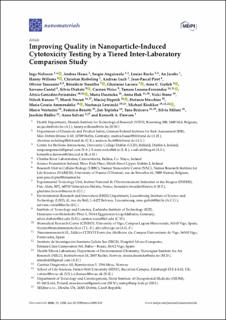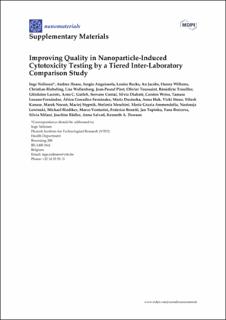| dc.contributor.author | Nelissen, Inge | |
| dc.contributor.author | Haase, Andrea | |
| dc.contributor.author | Anguissola, Sergio | |
| dc.contributor.author | Rocks, Louise | |
| dc.contributor.author | Jacobs, An | |
| dc.contributor.author | Willems, Hanny | |
| dc.contributor.author | Riebeling, Christian | |
| dc.contributor.author | Luch, Andreas | |
| dc.contributor.author | Piret, Jean-Pascal | |
| dc.contributor.author | Toussaint, Olivier | |
| dc.contributor.author | Trouiller, Benedicte | |
| dc.contributor.author | Lacroix, Ghislaine | |
| dc.contributor.author | Gutleb, Arno C. | |
| dc.contributor.author | Contal, Servane | |
| dc.contributor.author | Diabaté, Silvia | |
| dc.contributor.author | Weiss, Carsten | |
| dc.contributor.author | Lozano-Fernandez, Tamara | |
| dc.contributor.author | Gonzalez-Fernandez, Africa | |
| dc.contributor.author | Dusinska, Maria | |
| dc.contributor.author | Huk, Anna | |
| dc.contributor.author | Stone, Vicki | |
| dc.contributor.author | Kanase, Nilesh | |
| dc.contributor.author | Nocun, Marek | |
| dc.contributor.author | Stepnik, Maciej | |
| dc.contributor.author | Meschini, Stefania | |
| dc.contributor.author | Ammendolia, Maria Grazia | |
| dc.contributor.author | Lewinski, Nastassja | |
| dc.contributor.author | Riediker, Michael | |
| dc.contributor.author | Venturini, Marco | |
| dc.contributor.author | Benetti, Frederico | |
| dc.contributor.author | Topinka, Jan | |
| dc.contributor.author | Brzicova, Tana | |
| dc.contributor.author | Milani, Silvia | |
| dc.contributor.author | Rädler, Joachim | |
| dc.contributor.author | Salvati, Anna | |
| dc.contributor.author | Dawson, Kenneth A. | |
| dc.date.accessioned | 2020-08-10T07:45:42Z | |
| dc.date.available | 2020-08-10T07:45:42Z | |
| dc.date.created | 2020-08-07T10:38:06Z | |
| dc.date.issued | 2020 | |
| dc.identifier.citation | Nanomaterials. 2020, 10, 1430. | en_US |
| dc.identifier.issn | 2079-4991 | |
| dc.identifier.uri | https://hdl.handle.net/11250/2671265 | |
| dc.description.abstract | The quality and relevance of nanosafety studies constitute major challenges to ensure their key role as a supporting tool in sustainable innovation, and subsequent competitive economic advantage. However, the number of apparently contradictory and inconclusive research results has increased in the past few years, indicating the need to introduce harmonized protocols and good practices in the nanosafety research community. Therefore, we aimed to evaluate if best-practice training and inter-laboratory comparison (ILC) of performance of the 3-(4,5-dimethylthiazol-2-yl)-5-(3-carboxymethoxyphenyl)-2-(4-sulfophenyl)-2H-tetrazolium (MTS) assay for the cytotoxicity assessment of nanomaterials among 15 European laboratories can improve quality in nanosafety testing. We used two well-described model nanoparticles, 40-nm carboxylated polystyrene (PS-COOH) and 50-nm amino-modified polystyrene (PS-NH2). We followed a tiered approach using well-developed standard operating procedures (SOPs) and sharing the same cells, serum and nanoparticles. We started with determination of the cell growth rate (tier 1), followed by a method transfer phase, in which all laboratories performed the first ILC on the MTS assay (tier 2). Based on the outcome of tier 2 and a survey of laboratory practices, specific training was organized, and the MTS assay SOP was refined. This led to largely improved intra- and inter-laboratory reproducibility in tier 3. In addition, we confirmed that PS-COOH and PS-NH2 are suitable negative and positive control nanoparticles, respectively, to evaluate impact of nanomaterials on cell viability using the MTS assay. Overall, we have demonstrated that the tiered process followed here, with the use of SOPs and representative control nanomaterials, is necessary and makes it possible to achieve good inter-laboratory reproducibility, and therefore high-quality nanotoxicological data. | en_US |
| dc.language.iso | eng | en_US |
| dc.rights | Navngivelse 4.0 Internasjonal | * |
| dc.rights.uri | http://creativecommons.org/licenses/by/4.0/deed.no | * |
| dc.title | Improving Quality in Nanoparticle-Induced Cytotoxicity Testing by a Tiered Inter-Laboratory Comparison Study | en_US |
| dc.type | Peer reviewed | en_US |
| dc.type | Journal article | en_US |
| dc.description.version | publishedVersion | en_US |
| dc.rights.holder | ©2020 by the authors. Licensee MDPI, Basel, Switzerland. | en_US |
| dc.source.volume | 10 | en_US |
| dc.source.journal | Nanomaterials | en_US |
| dc.source.issue | 1430 | en_US |
| dc.identifier.doi | 10.3390/nano10081430 | |
| dc.identifier.cristin | 1822145 | |
| dc.relation.project | EC/FP7/262163 | en_US |
| dc.relation.project | Norges forskningsråd: 239199 | en_US |
| dc.relation.project | NILU - Norsk institutt for luftforskning: 114081 | en_US |
| cristin.ispublished | true | |
| cristin.fulltext | original | |
| cristin.fulltext | original | |
| cristin.qualitycode | 1 | |


